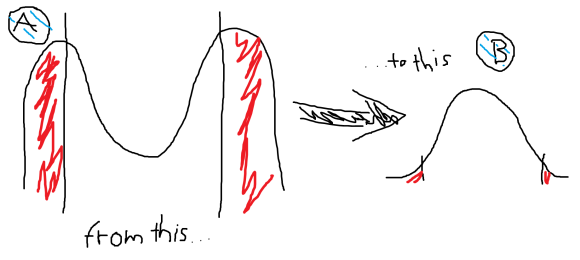The problem with online discussions and communities is that the extreme poles draw people effectively, causing group polarization in which the original opinion of a person becomes more radical due to influence of the group. In Finnish, we have a saying ”In a group, stupidity concentrates” (joukossa tyhmyys tiivistyy).
Here, I’m exploring the idea that this effect, namely the growth of polar extremes (for example, being for or against immigration, as currently many European citizens are) is simply because people are lacking options to identify with. There are only the extremes, but no neutral or moderate group, even though, as I’m arguing here, most people in fact are moderate and understand that extremes and absolutes are misleading simplifications either way.
In other words, when there are only two ”camps” of opinion, people are more easily split between them. However, my argument is that people have preferences that correspond to being in the middle, not in the extremes.
These preferences remain hidden because there are only two camps to subscribe to: One cannot be moderate because there is no moderate group.
For example, there are liberals and conservatives, but what about the people in the middle? What about them who share some ideas of liberals and others from conservatives? By having only these two groups, other combinations become socially impossible because people are, again socially, pressed to observe all the opinions of the group they’re subscribing to, even if they wouldn’t agree with a particular view. This effect has been studied in relation to the concept of groupthink, but no permanent remedy has been found.
How to solve the problem of extremes?
My idea is simple: we should start more camps, more views to subscribe to, especially those representing moderate views.
The argument is that having more supply of camps, people will distribute more evenly between them and we have less polarization as a consequence.
This is illustrated in the picture (sketched quickly in Paint since I got an inspiration).

In (A), public discourse is dominated by the extremes (the distribution of attention is skewed toward the extremes of a given opinion spectrum). In (B), the distribution is focused on the center of the opinion spectrum (=moderate views) while the extremes are marginalized (as they should be, according to the assumption of moderate majority).
An example: having several political parties results in more diverse views being presented. In the US, you are either a Democrat or a Republican (although there are marginal Green Party and the progressives, it must be stated), but in Finland you can also be many others: Center Party, National Coalition Party, or Green Party, for example. The same applies to most countries in Europe. Although I don’t have facts for this, it seems that the public discourse in the US is exceptionally polarized compared to many other countries [1].
Giving more choices to identify with for the ”silent majority” that is moderate rather than extreme, revealing the ”true” opinions of citizens, would ideally marginalize both extremes, avoiding the tyrannity of minority [2] currently dominating the public discourse.
Finally, all this could be formalized in game theory by assuming heterogeneity of preferences over the opinion spectrum and parameters such as gravity (”pull factor” by the extremes), justifiable e.g. by media attention given to extreme views over moderate ones. But the implication reains the same: diversity of classes reduces polarization under the set of assumptions.
Footnotes
[1] Of course there are other reasons, such as media taking political sides.
[2] This means extreme views are not representative to the whole population (which is more moderate than either view) but they get disproportionate attention in the media and public discourse. This is because the majority views are hidden; they would need to be revealed.
